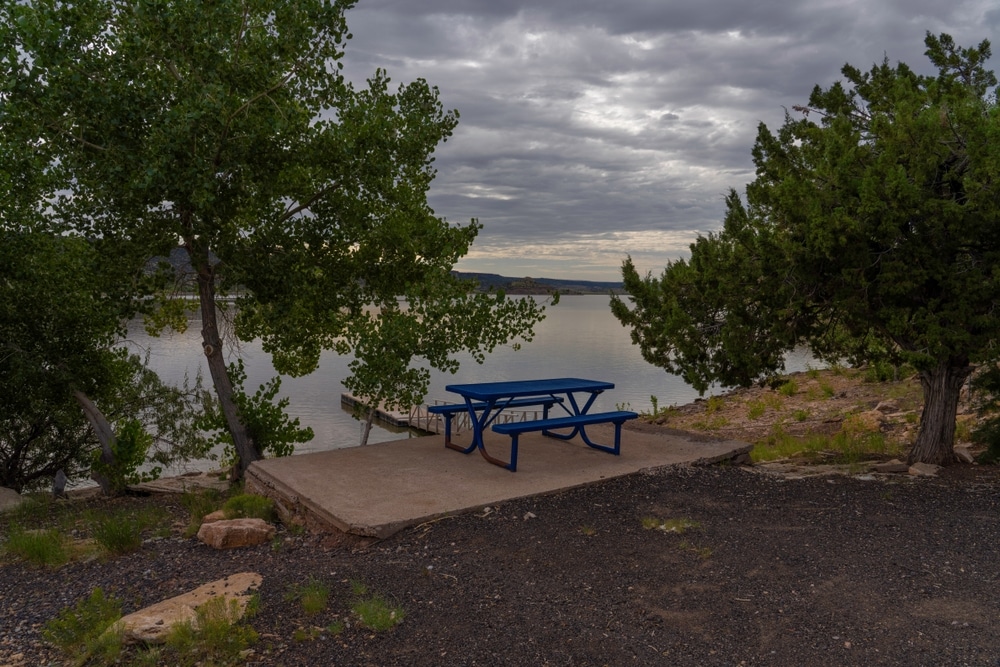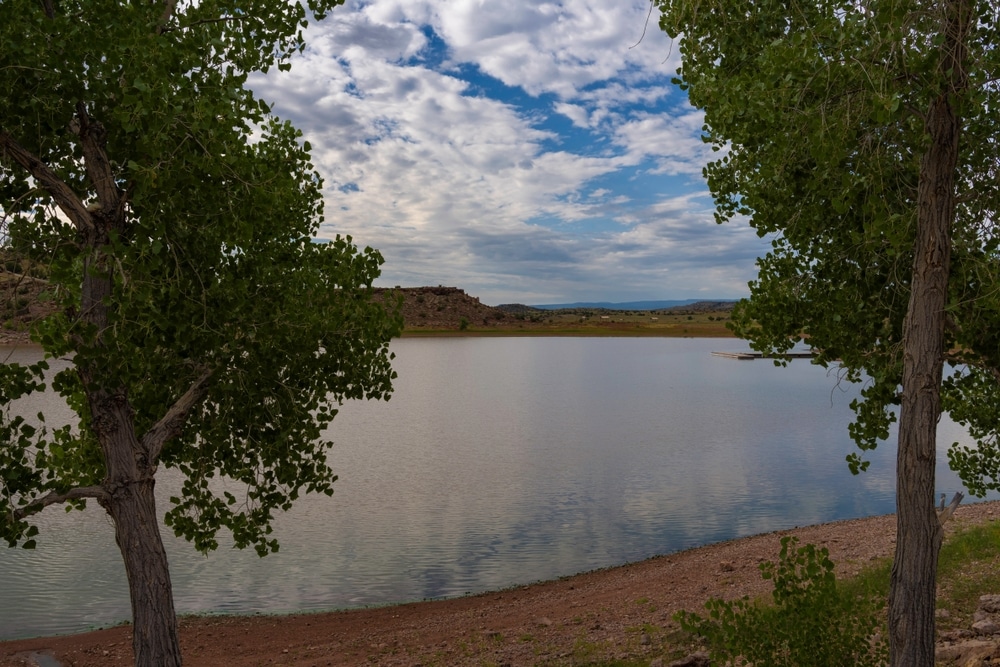- Privacy
- Terms
- Stay Connected
Nestled in the rolling grasslands of northeastern Arizona at an elevation of 6,000 feet, Lyman Lake State Park offers visitors a refreshing escape from the desert heat and a wealth of recreational opportunities. Created in 1961 as one of Arizona’s early state parks, this 1,200-acre reservoir was originally formed by damming the Little Colorado River to provide irrigation water for nearby agricultural communities. Today, it stands as one of the few substantial bodies of water in northeastern Arizona that has no size restrictions for boats, making it a premier destination for water enthusiasts.
Located approximately 17 miles north of Springerville-Eagar in Apache County (GPS coordinates: 34.3622° N, 109.3611° W), Lyman Lake sits at the edge of the Colorado Plateau, where the high desert meets the pine forests of the White Mountains. The park is easily accessible via Highway 191/180, approximately 3.5 hours east of Phoenix and 4 hours northeast of Tucson.

What makes Lyman Lake particularly significant within Arizona’s park system is its dual nature as both a recreational haven and a site of archaeological importance. The park not only preserves a vital water resource in an otherwise arid landscape but also protects prehistoric sites dating back nearly 1,000 years. The remnants of ancient pueblos and a remarkable collection of petroglyphs offer visitors a glimpse into the lives of the region’s indigenous peoples.
Key highlights of the park include its uncrowded beaches, excellent fishing opportunities, and the fascinating Petroglyph Trail that showcases ancient rock art. Whether you’re looking to cool off during Arizona’s hot summer months, reel in a trophy-sized fish, explore archaeological treasures, or simply enjoy the stunning high-country scenery, Lyman Lake offers a diverse range of experiences that set it apart from more crowded destinations in the state park system.
Located in northeastern Arizona with minimal light pollution, Lyman Lake provides excellent conditions for astronomical observation. The clear, high-desert air creates ideal conditions for viewing stars, planets, and celestial events. The open areas near the lakeshore provide unobstructed views of the night sky, while the park occasionally hosts astronomy programs with telescopes and guided constellation tours.

The designated swimming area features a sandy beach with gradual entry, making it ideal for families with children. This protected cove provides safer swimming conditions away from boating areas. The beach includes shade ramadas, picnic tables, and nearby restroom facilities for comfortable day use. The relatively warm water temperatures during summer months make swimming particularly enjoyable.

Lyman Lake offers 1,500 acres of water surface with no size restrictions on boats, making it one of the few large lakes in northeastern Arizona open to all watercraft types. The expansive waters accommodate everything from kayaks and sailboats to speedboats and personal watercraft. The main basin provides ample space for water skiing and wakeboarding, while the quieter coves offer peaceful paddling opportunities. The park maintains two boat ramps with adjacent parking for convenient lake access.

The lake supports diverse fish populations including largemouth bass, channel catfish, carp, and rainbow trout (stocked seasonally). The western end near the dam offers deeper waters productive for trout fishing, while the eastern shallows and coves yield better results for bass and catfish. Shore fishing is accessible along much of the lake perimeter, with fishing piers providing additional access points. The park store offers basic fishing supplies and local fishing information.

Several hiking trails wind through the park, showcasing diverse landscapes from shoreline paths to mesa-top routes. The Buffalo Trail offers panoramic lake views from higher elevations, while the Peninsula Trail explores the unique volcanic features that characterize this region. These paths provide opportunities to observe native plants, geological formations, and wildlife in their natural settings.

The park contains significant archaeological resources, including remarkable petroglyphs (rock art) created by prehistoric peoples. The Peninsula Petroglyph Trail leads visitors to panels of ancient carvings depicting various symbols and figures. Interpretive signage explains the potential meanings and cultural significance of these artifacts, offering glimpses into the lives of those who inhabited this region centuries ago.

The lake environment attracts diverse wildlife including waterfowl, shorebirds, and various mammal species. Mule deer, pronghorn antelope, and coyotes are occasionally spotted in early morning and evening hours. The lake serves as an important stopover for migratory birds, with spring and fall offering particularly good bird watching opportunities. The visitor center provides wildlife checklists and information about seasonal species.

Lyman Lake features multiple camping options including 56 developed sites with electricity and water hookups that accommodate tents and RVs. For more adventurous visitors, eight primitive cabins provide rustic overnight accommodations with basic furnishings. The campground includes modern restrooms with hot showers and a dump station. The lakeside sites offer beautiful water views and easy access to swimming and fishing opportunities.

Multiple day-use areas around the lake offer picnic tables, grills, and shade ramadas with scenic water views. These facilities are strategically placed to take advantage of shoreline vistas while providing comfort in the often sunny environment. Group picnic areas with larger capacity are available by reservation for family gatherings and special events.

| Detail | Information |
|---|---|
| Location | St. Johns, Arizona (northeastern Arizona) |
| Established | 1961 |
| Size | 1,200 acres (lake: 1,500 acres when full) |
| Elevation | 6,000 feet |
| Lake Origin | Created by damming the Little Colorado River |
| Water Features | One of the few large lakes in northeastern Arizona without size restrictions for boats |
| Activities | Boating, fishing, swimming, hiking, camping, picnicking, water skiing, birdwatching |
| Fish Species | Largemouth bass, channel catfish, carp, walleye, rainbow trout |
| Camping Options | 56 campsites (38 with electric/water hookups), 8 cabins available for rent |
| Notable Trails | Peninsula Petroglyph Trail featuring ancient Native American rock art |
| Archaeological Sites | Nearby petroglyphs, grinding stones, pottery sherds from prehistoric peoples |
| Wildlife | Waterfowl, shorebirds, raptors, mule deer, antelope, occasional elk |
| Seasonal Operation | Generally open year-round, with some limited services in winter |
| Winter Activities | Ice fishing (when conditions permit) |
| Amenities | Boat ramp, beach area, fishing docks, ranger station, showers, dump station |
| Climate | High desert climate: hot summers, mild springs/falls, cold winters |
Lyman Lake is a substantial high-country reservoir encompassing approximately 1,200 surface acres when at full capacity. The lake stretches across 4.5 miles of shoreline, with depths reaching up to 57 feet near the dam. This sizeable body of water was created by the construction of Lyman Dam, which was completed in 1913 by the Lyman Water Company for irrigation purposes.
The dam itself is an impressive structure, standing 57 feet high and 600 feet long. Built as an earth-fill dam with a concrete core, it was one of the earlier significant water projects in northern Arizona. The reservoir it creates can store approximately 30,500 acre-feet of water, providing crucial irrigation resources for the agricultural communities in the Little Colorado River watershed. In 1961, the dam and surrounding land were designated as a state park, balancing the original agricultural purpose with recreational opportunities.
The landscape surrounding Lyman Lake presents a fascinating transition zone between ecological regions. Situated at the edge of the Colorado Plateau, the park features a mixture of high desert scrubland and the beginnings of the montane forests that dominate the nearby White Mountains. The terrain consists of rolling grasslands dotted with juniper and piñon pine, volcanic outcroppings, and colorful sedimentary formations.
One of the most notable geological features within the park is Peninsula Bluff, a dramatic rock formation that juts into the lake, creating a natural dividing line between the bigger, deeper section used primarily for boating and a smaller, no-wake zone popular with anglers and paddlers. The bluff offers expansive views of the lake and surrounding countryside.
The park also contains badland-type formations of multicolored clays and volcanic materials. These geological features not only provide a striking backdrop for recreational activities but also offer a window into the region’s volcanic past, when lava flows and ash falls shaped much of the northeastern Arizona landscape.
Lyman Lake is fed primarily by the Little Colorado River, which begins its journey in the White Mountains before flowing northward through the park and eventually joining the Colorado River at the eastern end of the Grand Canyon. The watershed encompasses approximately 790 square miles of eastern Arizona, collecting snowmelt and monsoon rainfall from a diverse landscape of mountains, forests, and grasslands.
The lake’s water levels can fluctuate significantly throughout the year, typically reaching their highest point in spring following snowmelt and dropping during summer and fall as water is released for agricultural use downstream. This fluctuation creates dynamic shoreline conditions that influence both recreational opportunities and wildlife habitats throughout the seasons.
The water clarity varies seasonally, with clearer conditions typically occurring in winter and early spring before the summer algae growth. The lake’s relatively high elevation of 6,000 feet helps moderate water temperatures, making it a refreshing destination during Arizona’s hot summer months while still warming enough for comfortable swimming from late May through September.
The vegetation around Lyman Lake reflects its position in a transition zone between the Colorado Plateau and the higher elevations of the White Mountains. The most common plant communities include piñon-juniper woodland, high desert scrub, and riparian zones along the lakeshore.
Dominant tree species include the Utah juniper (Juniperus osteosperma) and piñon pine (Pinus edulis), which form scattered woodlands throughout the park. These hardy trees have adapted to the region’s limited rainfall and intense sun exposure. The understory features a variety of drought-resistant shrubs such as rabbitbrush (Chrysothamnus nauseosus), four-wing saltbush (Atriplex canescens), and various sagebrush species.
In spring and summer, wildflowers add splashes of color to the landscape, including Indian paintbrush (Castilleja), globe mallow (Sphaeralcea), and various penstemons. Along the lakeshore and in moister areas, visitors might spot cottonwoods (Populus fremontii), willows (Salix spp.), and cattails (Typha latifolia).
The diverse habitats within Lyman Lake State Park support a remarkable variety of wildlife. Mammals commonly seen include mule deer, coyotes, jackrabbits, cottontails, and ground squirrels. Lucky visitors might glimpse more elusive residents such as bobcats, badgers, or even an occasional elk that has wandered down from the higher elevations of the White Mountains.
The lake itself attracts numerous species, including muskrats and beavers, which can sometimes be spotted along the shoreline during early morning or evening hours. During summer months, bat species emerge at dusk to feed on insects above the water’s surface, creating an impressive aerial display.
Lyman Lake is a paradise for bird watchers, with over 200 species documented in and around the park throughout the year. The lake serves as an important stopover for migratory birds along the western flyway, particularly during spring and fall migrations.
Waterbirds are abundant, including American white pelicans, double-crested cormorants, great blue herons, and various duck species. The western and eared grebes often perform their spectacular courtship dances on the lake during spring. Ospreys and bald eagles are regular visitors, particularly during winter months when they hunt for fish in the lake’s waters.
The surrounding uplands host golden eagles, prairie falcons, and a variety of hawks. Smaller birds include western bluebirds, mountain chickadees, pinyon jays, and numerous sparrow species. Dawn chorus during spring months can be particularly impressive, with dozens of species contributing their voices.
While not commonly seen, the park’s watershed is within the range of several species of conservation concern. These include the southwestern willow flycatcher (Empidonax traillii extimus), which may occasionally use riparian habitat along the lake’s inflow and outflow areas. The northern leopard frog (Lithobates pipiens), though not endangered, has experienced significant declines across the Southwest and maintains populations in some of the quieter backwaters of the lake.
The lake’s fish community includes the Little Colorado spinedace (Lepidomeda vittata), a threatened species native to the Little Colorado River system, though it is rarely encountered by anglers.
Lyman Lake undergoes dramatic seasonal transformations. Winter brings snow-dusted juniper and pine, with ice sometimes forming in protected coves. Waterfowl numbers peak as migrants arrive from northern breeding grounds. Spring triggers a burst of wildflower activity, especially after wet winters, with plant communities progressing from lower to higher elevations as temperatures warm.
Summer brings the most biological activity, with flourishing aquatic vegetation, algae blooms in nutrient-rich areas, and active reptile populations including western fence lizards, plateau lizards, and various snake species. The monsoon season (typically July through September) brings afternoon thunderstorms that temporarily transform dry washes into flowing streams and stimulate late-summer plant growth.
Fall brings cooling temperatures, changing colors in deciduous vegetation along the shoreline, and the gradual departure of summer bird species as winter residents begin to arrive. This seasonal cycle creates ever-changing conditions that reward repeat visits throughout the year.
Lyman Lake’s generous size and lack of boating restrictions make it a popular destination for a wide range of water activities. Unlike many smaller lakes in Arizona, Lyman Lake permits all watercraft types with no horsepower limitations, allowing everything from jet skis and speedboats to pontoons and houseboats.
The lake is effectively divided into two sections by Peninsula Bluff: the larger main body of water where all boating is permitted, and a smaller no-wake zone that provides calmer waters for paddling, fishing, and swimming. Two well-maintained boat ramps provide easy access, with the main ramp near the dam operating year-round except during extreme low water conditions.
Swimming is popular during summer months, with a designated beach area featuring shallow, gradually sloping entry points ideal for families with children. The swimming area includes picnic tables, shade ramadas, and restroom facilities nearby. Water temperatures typically reach the mid-70s°F by June and can maintain swimming-friendly temperatures through mid-September.
For those who prefer human-powered watercraft, the park offers excellent opportunities for kayaking, canoeing, and stand-up paddleboarding. The no-wake zone is particularly popular for these activities, allowing paddlers to explore coves and inlets without competing with motorized craft. Rentals are available at the park store during summer months, including single and tandem kayaks, canoes, and paddleboards.
Lyman Lake is renowned as one of northeastern Arizona’s premier fishing destinations, with a diverse fish population that provides year-round angling opportunities. The Arizona Game and Fish Department actively manages the fishery, regularly stocking rainbow trout during cooler months (October through April) while natural populations of warm-water species thrive during summer.
Common Fish Species:
Best Fishing Spots:
Fishing Regulations and Licenses: All anglers 10 years and older must possess a valid Arizona fishing license, available online through the Arizona Game and Fish Department website, at the park store, or from various retailers in nearby Springerville-Eagar. Standard statewide bag and possession limits apply for most species, though special regulations may be in effect for certain fish—check current regulations before your visit.
Shore fishing is accessible throughout much of the park, with the Peninsula Bluff area and the dam being particularly popular spots. Ice fishing is occasionally possible during particularly cold winters, though ice conditions can be unpredictable and safety precautions should always be observed.
While Lyman Lake State Park is primarily known for its water recreation, several hiking trails offer opportunities to explore the surrounding landscape and archaeological features.
Petroglyph Trail
Peninsula Trail
Buffalo Trail
Environmental Study Area Trail
Photographers will find abundant opportunities to capture the beauty of Lyman Lake and its surroundings. The most popular photography locations include:
The park’s relatively dark skies also make it an excellent location for night photography, particularly during new moon periods when the Milky Way is visible arching over the lake.
Lyman Lake’s elevation and distance from major urban centers result in minimal light pollution, creating ideal conditions for stargazing. The park occasionally hosts star parties and astronomy events during summer months, often in partnership with local astronomy clubs or educational institutions.
The best stargazing locations within the park include the open areas near the beach, which provide unobstructed views of the night sky, and the higher elevations along Peninsula Bluff. During clear, moonless nights, visitors can observe the Milky Way, numerous constellations, and even meteor showers during peak periods like the Perseids (August) or Geminids (December).
For serious astronomers, the park permits telescopes and offers several sites with level ground suitable for setting up equipment. The park’s campgrounds enforce quiet hours after 10 PM, helping to create an atmosphere conducive to night sky observation.
Lyman Lake State Park offers diverse camping options to accommodate various preferences and equipment types. The park features 61 developed campsites spread across two main camping areas: the Lakeview Campground and the Peninsula Campground.
Types of Sites:
Amenities and Facilities: Both campgrounds provide clean, well-maintained restrooms with flush toilets and hot showers. Additional amenities include:
The campgrounds are designed to blend with the natural environment, with native vegetation providing some separation between sites. Many sites offer partial views of the lake, while the Peninsula Campground sites are closer to the water’s edge.
Reservation Information: Campsite reservations can be made up to six months in advance through the Arizona State Parks reservation system (online or by phone at 1-877-MY-PARKS). Reservations are strongly recommended during peak season (April through October) and for all weekends and holidays year-round. A limited number of sites are kept available for same-day, walk-in registration on a first-come, first-served basis.
Camping fees (as of 2024):
The maximum stay limit is 14 consecutive days.
For visitors seeking more comfortable accommodations, Lyman Lake State Park offers eight rental cabins located on a hillside overlooking the lake. These cabins provide a convenient “glamping” option for those who want to enjoy the park experience without tent or RV camping.
Each cabin features:
Cabins do not include bathrooms or kitchens; guests use the nearby campground restroom and shower facilities. Bedding is not provided, so guests must bring their own sheets, blankets, and pillows. Cooking must be done outside using the provided fire ring (with grill) or on camp stoves brought by guests.
Cabin reservations can be made up to six months in advance through the same reservation system as campsites. The current rate is $65 per night plus tax, with a two-night minimum stay on weekends during peak season. Cabins are extremely popular, so early reservations are essential, particularly for summer weekends and holidays.
For those who prefer hotel accommodations or when the park’s facilities are fully booked, several options are available within a short driving distance:
Lyman Lake State Park enforces several regulations to ensure a positive experience for all visitors:
Tips for a Successful Camping Experience:
Lyman Lake State Park is open year-round, though services and facilities vary seasonally:
While the park never completely closes to overnight guests, the main gate may be closed during late night hours; registered campers receive a gate code for after-hours access.
Seasonal considerations include:
Current entrance fees for Lyman Lake State Park are:
Payment methods accepted include cash, major credit cards, and debit cards. Entrance fees are separate from camping fees and are required even for those with camping reservations.
Several pass options can provide savings for frequent visitors:
America the Beautiful passes (National Parks and Federal Recreational Lands passes) are NOT accepted at Arizona State Parks, including Lyman Lake.
Each season at Lyman Lake offers different advantages depending on your interests:
Lyman Lake’s elevation of 6,000 feet creates a climate distinct from both the lower desert regions of Arizona and the higher mountain communities:
Visitors should always check weather forecasts before water activities and be prepared for rapid changes in conditions. The afternoon thunderstorms of monsoon season require particular attention, as they can develop quickly and create dangerous conditions for boaters.
Lyman Lake State Park has made significant efforts to improve accessibility for visitors with mobility challenges and other disabilities:
Visitors with specific accessibility needs are encouraged to call the park office in advance of their visit to discuss accommodations and current conditions.
Pets are welcome at Lyman Lake State Park under the following guidelines:
The park features several pet-friendly trails and a large day-use area where leashed pets can be exercised. Water is available at various locations throughout the park to keep pets hydrated, particularly important during warmer months.
Cell phone coverage at Lyman Lake State Park is limited and varies by carrier:
Wi-Fi service is available for visitors:
Visitors planning to work remotely or requiring consistent connectivity should consider the connectivity limitations when planning their stay. The nearby communities of Springerville-Eagar (17 miles south) offer more reliable cell service and several businesses with Wi-Fi.
The Lyman Lake State Park Visitor Center is located near the park entrance and serves as the hub for information, registration, and basic supplies. The modestly sized but well-designed facility features:
Visitor Center hours mirror the park office hours:
The visitor center offers orientation talks for groups by prior arrangement and maintains current information about trail conditions, water levels, and wildlife sightings. Rangers can provide recommendations tailored to visitors’ interests and abilities.
Lyman Lake State Park maintains several restroom facilities throughout the property:
All restroom buildings are cleaned and maintained daily, with more frequent service during peak visitation periods. Drinking water is available at most restroom locations. The shower facilities include changing areas and operate year-round in the campground restroom buildings, though water conservation measures sometimes limit shower availability during drought conditions.
The park features several designated picnic areas that accommodate both individual families and larger groups:
Group ramadas can be reserved for a fee of $25 per day through the park reservation system. Individual picnic sites are available on a first-come, first-served basis. All picnic areas include nearby restroom facilities and trash receptacles.
During summer weekends and holidays, picnic areas fill quickly, so early arrival is recommended to secure preferred locations.
Lyman Lake offers two boat launch facilities:
The park does not have a full-service marina but does offer:
There are no fuel services on the lake; boaters must bring their own fuel supplies from nearby communities. The nearest full-service marina with repairs, extensive docking, and fueling capabilities is at Big Lake, approximately 35 miles southwest of Lyman Lake.
Families with children will find several recreational facilities designed for younger visitors:
All recreational areas are alcohol-free and designated as family-friendly zones. Most areas have some form of shade structure, though visitors are encouraged to bring additional sun protection during summer months.
The Lyman Lake Park Store is located adjacent to the visitor center and offers a variety of supplies and conveniences:
The store operates on the same schedule as the visitor center, with extended evening hours (until 8 PM) during peak summer weekends. Payment methods accepted include cash and major credit cards. An ATM is available in the store for visitor convenience.
For more extensive shopping needs, the communities of Springerville and Eagar (17 miles south) offer full-service grocery stores, sporting goods outlets, and hardware stores.
Lyman Lake State Park serves as an excellent base for exploring other notable natural areas in northeastern Arizona:
The nearby communities offer services, cultural experiences, and local flavor:
The White Mountains region has a rich cultural heritage reflected in several accessible sites:
Several local establishments enhance the visitor experience:
Lyman Lake State Park actively works to preserve and protect its natural and cultural resources through several ongoing initiatives:
Visitors play a crucial role in preserving Lyman Lake State Park for future generations. Park rangers emphasize these key responsibilities:
Lyman Lake State Park offers several volunteering programs for those interested in contributing to park operations and conservation:
Those interested in volunteering can contact the park office for current opportunities and application procedures. Arizona State Parks also offers a park-wide volunteer program that can match volunteers with positions based on their interests and availability.
The park offers several educational programs that help visitors understand and appreciate the natural and cultural resources of the area:
Program schedules are posted at the visitor center and on the park’s website. Some specialty programs require advance registration due to limited capacity.
Lyman Lake State Park actively promotes and follows Leave No Trace principles, a nationally recognized framework for outdoor ethics:
The land surrounding Lyman Lake has been home to indigenous peoples for thousands of years. Archaeological evidence indicates that the area was used by Ancestral Puebloan (Anasazi) peoples as early as 500 CE, with more substantial occupation between 1000-1400 CE. The petroglyphs preserved within the park represent some of the most accessible examples of indigenous rock art in northeastern Arizona.
The region later became part of the traditional territory of the Western Apache, particularly the White Mountain band. These semi-nomadic peoples utilized the area seasonally for hunting and gathering, valuing the reliable water source and diverse plant communities. Several place names in the vicinity derive from Apache language terms.
Today, the White Mountain Apache Tribe maintains cultural connections to the area. The park occasionally hosts cultural events where tribal members share aspects of their heritage through storytelling, craft demonstrations, and educational presentations. Park interpretive materials acknowledge the indigenous history of the land and incorporate indigenous perspectives where appropriate.
Visitors interested in deeper understanding of indigenous connections to the region are encouraged to also visit the White Mountain Apache Cultural Center at Fort Apache and the Museum of the Mountain West in Springerville.
European-American settlement of the Little Colorado River watershed began in earnest in the 1870s, with Mormon pioneers establishing communities throughout the region. The area around what is now Lyman Lake was settled largely by members of the Church of Jesus Christ of Latter-day Saints looking to expand their presence in the Arizona Territory.
The lake itself is named for Francis M. Lyman, an apostle of the LDS Church who directed much of the Mormon colonization effort in northeastern Arizona. The Lyman family was instrumental in developing water resources in the region, recognizing that controlling water was essential to successful agriculture in the arid climate.
Construction of Lyman Dam began in 1912 and was completed in 1913, representing a significant engineering achievement for the time. The dam and resulting reservoir transformed the agricultural potential of the valley, allowing for more consistent irrigation and expanded crop production. The Lyman Water Company, a cooperative of local landowners, managed the reservoir for decades before the creation of the state park.
Perhaps the most significant cultural resources within the park are the archaeological sites that provide evidence of prehistoric human occupation. These include:
To protect these irreplaceable resources, some archaeological sites within the park have restricted access or are not publicly disclosed. All archaeological resources are protected by federal and state laws; collection of artifacts is strictly prohibited and violations are prosecuted.
Lyman Lake State Park plays a significant role in the regional economy, particularly for the communities of Springerville, Eagar, and St. Johns. The park attracts approximately 80,000 visitors annually, many from outside the immediate area.
These visitors contribute to the local economy through:
A 2019 economic impact study estimated that Lyman Lake State Park generates approximately $2.3 million in annual economic activity for Apache County, supporting approximately 25 full-time equivalent jobs both within and outside the park.
The park also serves as a gateway to other recreational and cultural attractions in the White Mountains region, encouraging visitors to extend their stays and explore more of what northeastern Arizona has to offer. This multiplier effect amplifies the economic significance of the park beyond its direct revenue generation.
Yes, the designated swimming area is monitored regularly for water quality. There are no lifeguards on duty, so swimming is at your own risk. The beach area has a gradual entry making it suitable for families with children.
Due to concerns about invasive insects, particularly the bark beetle, outside firewood is discouraged. Firewood is available for purchase at the park store or from approved vendors in nearby communities.
The campground shower facilities are restricted to overnight guests. Day-use visitors have access to rinse showers at the beach area during summer months only.
Hunting is not permitted within the developed areas of the park. Limited hunting may be allowed in designated areas during specific seasons; check with the park office for current regulations.
The park offers kayak, canoe, and stand-up paddleboard rentals during summer months, but does not rent motorized boats. Several businesses in Springerville-Eagar offer boat rentals that can be transported to the lake.